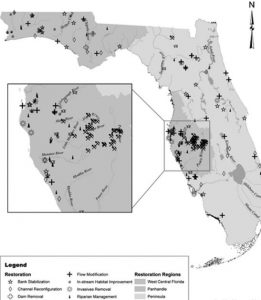 MOSSA – A Synthesis of Stream Restoration Efforts in Florida (USA)
MOSSA – A Synthesis of Stream Restoration Efforts in Florida (USA)
D. Castillo, D. Kaplan, J. Mossa
Article first published online: 22 MAR 2016 River Research and Applications
DOI: 10.1002/rra.3014
ABSTRACT:
Studies summarizing stream restoration projects in the US are outdated and omit the majority of restoration projects in Florida. To address this gap, we compiled stream restoration data from diverse sources to create a Florida Stream Restoration Database (FSRD, available at http://www.watershedecology.org/databases.html) containing information on project type, location, completion date, and costs. The FSRD contains 178 projects categorized by restoration type, including riparian management (23%), stream reclamation (19%), flow modification (13%), bank stabilization (12%), channel reconfiguration (11%), in-stream habitat improvements (11%), floodplain reconnection (6%), invasive species removal (4%), and dam removal (1%). Projects were spatially clustered into three geographic regions, providing insight on the diversity of initiatives, needs, and funding sources of land management agencies and private landowners that motivated restoration efforts. Projects in the Florida panhandle emphasized in-stream habitat restoration, while peninsular projects were dominated by flow modification, and projects in the west central region focused on stream reclamation to mitigate surface mining practices and water quality and habitat improvements in tidal streams. Results suggest that Florida is spending much more on stream restoration than previously documented. Between 1979 and 2015, the mean and median stream restoration project costs in Florida were $15.4 million and $180?000, respectively, indicating a strongly skewed distribution because of the large Kissimmee River restoration project in central Florida. This work highlights the need for, and utility of, statewide and national restoration databases to improve restoration tracking. This need will become increasingly critical as more stringent water quality and habitat mitigation rules are implemented across the country.
Read the full publication at River Research and Applications